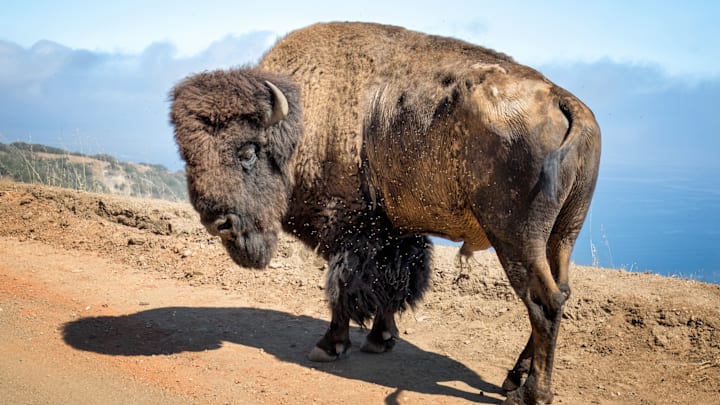Every summer, more than a million people flock to a small California island to relax on sandy beaches, swing golf clubs, and take in the local wildlife—a herd of bison.
Catalina Island is a rocky speck off the coast of Southern California, lying almost parallel to the city of Los Angeles. Like many islands, it boasts a unique ecosystem with more than 50 plants and animals found nowhere else in the world. But this land of rolling hills, rugged canyons, and beautiful beaches is also prone to invasive species, and its history has allowed for several unconventional introductions.
A Brief History of Catalina Island
Real estate magnate James Lick bought the island in 1867 and offered leases for grazing sheep, cattle, and goats. One of his ranchers, Augustus William Timms, diversified his business by using the boat Rosita to ferry tourists across the channel. These two industries—farming and tourism—continued to shape the island as ownership passed to George Shatto, who established its town of Avalon, and then later to the Wrigley family of chewing-gum fame.
Bison were brought to the island in 1924 for a Hollywood film, but exactly which director or movie remains a mystery. The large ungulates adapted fairly well to their new environment and became a hit with tourists. In 1934, Wrigley arranged for nine more bison to be brought from the mainland; by 1969, there were approximately 400 bison in the herd [PDF].
Catalina Island, like all islands, exists in a delicate ecological balance. It’s just 75 square miles, with much of it covered by unique species of native grass. In 1972, Philip K. Wrigley helped found the Catalina Island Conservancy, a nonprofit organization with a goal to preserve and restore the area’s natural habitat after decades of destruction from farm animals. Through private land donations, the conservancy owned 88 percent of the island by 1975.
Perhaps the newfound Conservancy’s most unusual task was to figure out what to do with the island’s bison herd. It estimated the island could only support between 150 to 200 bison. At the time, the best way to reduce the herd was to ship the animals to the mainland; almost 2000 were relocated between 1969 and 2003. But the operation was costly, as well as potentially dangerous for both the bison and humans. So the Conservancy began looking toward a very different kind of herd management: birth control.
The Dawn of PZP
The search for a birth control option for ungulates began in the American West, where feral horses were running a bit too free: Their populations were doubling roughly every five years. Today, herds are restricted to areas managed by the Bureau of Land Management and Forest Service. Like bison, relocating a feral horse is expensive and dangerous. So the U.S. government began looking into birth control options.
Porcine zona pellucida, also known as PZP, is a protein found in the ovaries of female pigs. When injected into a female horse, the mare’s immune system produces antibodies that bind to their eggs. These antibodies create a wall that blocks fertilization, preventing the sperm from attaching to an egg in a process called “immunocontraception.”
Prior to the Catalina Island bison, the most comprehensive study of PZP was of the Assateague Island pony herd, which is managed by the National Park Service. In 1965, there were 21 ponies on the Maryland portion of the island; in 1994, there were 167, all munching on endangered seabeach amaranth plants [PDF]. A 10-year study of the drug found that it not only reduced the herd to a sustainable 75 equines, but was also a model of NPS and public cooperation.
In most cases, PZP is temporary and reversible. Mares that were already pregnant when injected had no complications and delivered healthy foals [PDF]. But horses aren’t the only animal to be treated with PZP. Tests have also been carried out on elephants in South Africa, bears in New Jersey [PDF] and sea lions in California. The Catalina Island Conservancy was confident it was the right drug for the job for the island’s bison herd, too.
Bison on Birth Control
When the Conservancy first proposed using PZP for birth control in 2003, there were about 350 bison on Catalina Island. On average, two-thirds of females would give birth every year. But the effects of living in coastal California were visible—the Catalina bison were smaller than their mainland counterparts, and had open sores from nutrient deficiencies. The Conservancy hoped that reducing the herd size would improve their overall health.

Scientists began injecting female bison with PZP using a long-range dart gun in 2009. The results were immediate. In 2011, only about 10 percent of females gave birth; in 2012, the birthrate dropped to 3.3 percent. And in 2013, only one calf was born. The Conservancy named him Uno.
But the birth control might have worked too well. No calves have born following Uno, even after the Conservancy scaled back its darting in 2015. For an island selling bison tours, bison knickknacks, and “buffalo milk” cocktails, a herd that’s dwindled to below 100 animals is worrying. The Conservancy even considered bringing two pregnant bison to the island in 2020, but was unable to due to the pandemic.
The lack of calves might be the result of forces much larger than PZP. Climate change has been especially evident in Southern California, with rising temperatures and increased fire risk. During the state’s most severe drought on record, which lasted from 2012 to 2016, the Conservancy began to supply the herd with troughs of water. The bison may have stopped reproducing because of the birth control, but the trend could be continuing because of the ongoing drought conditions. Perhaps the Catalina Island herd ultimately doesn’t need birth control, and the bison have simply made the decision that now isn’t the right time to start a family.
Read More Stories About Animals Here:
